Important information will be about what first arise, if the infection still happened, and what to do next.
Some useful facts about ticks and diseases carried by them
Before talking about precautions, it is necessary to understand the fundamental points that relate to mites and the diseases that they suffer.
Mites are scientifically classified as arachnid arthropods, which are some of the oldest living organisms on our planet. The fossils found suggest that the mite already exists for at least 90 million years.
Most tick bites do not transmit harmful microbes. The main misconception of many people is that it is believed that if a tick bites or is found on the body, then the infection can not be avoided. The tick is a carrier of the causative agent only if its early immature form is a nymph bitten before that by an animal that was a reservoir of infection. Such a phenomenon in nature occurs on so often.
There is no single tick disease. This is a number of human infectious diseases that can be transmitted with a tick bite, there are about 50 of them. Such a wide spectrum of pathogens includes bacteria, viruses and protozoa, some even capable of killing a person without treatment.
There are quite a lot of symptoms that usually develop from a few days to several weeks after a tick bite. Symptoms depend on the specific pathogen that was transmitted with the tick saliva at the time of the bite.
Later, in the area of a bite a person can develop itching, burning, redness and rarely - localized intense pain if the wound falls into the area of a large nerve. Also, the manifestation of symptoms strongly depends on the individual's perception of the person.
In some patients, hypersensitivity or allergy to saliva of ticks is noted. As a result, a rash develops on the skin, shortness of breath, swelling, numbness or paralysis. And since, as the bite of a tick looks like, one can not say for sure, each person has his own symptoms, most people with tick bites do not show any symptoms and can not even remember that they were bitten by a tick.
Some immediate symptoms of infectious diseases that can develop after a tick bite:
- Fever.
- Dyspnea.
- Weakness.
- Vomiting.
- Swelling on the body.
- Strong headache.
- Confusion of consciousness.
- Increased palpitation and heavy breathing.
At the first manifestation of similar symptoms, you should immediately contact a medical institution.
Recently, researchers have found that a tick bite in an anamnesis provokes an allergy to red meat - beef, pork, venison and sometimes milk. And for meat of poultry (chicken, turkey), there are no allergic reactions. It is believed that this reaction is due to the formation of antigens in the intestine, stimulated by the saliva of the tick. Experienced evidence of this theoretical hypothesis is not yet available.
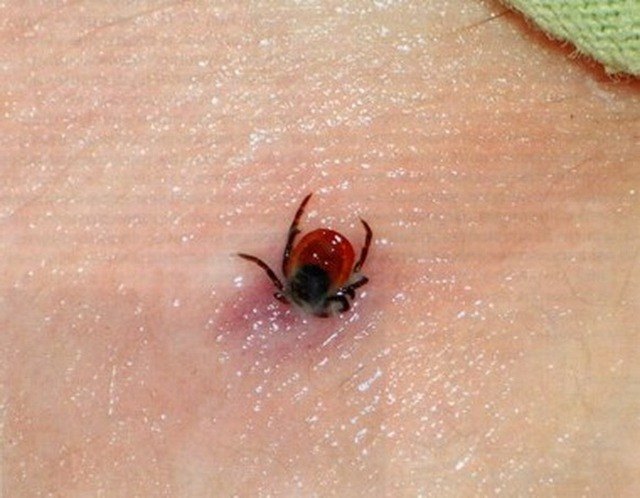
What diseases do ticks transmit?
Although most tick bites do not transmit pathogens, in some cases this is possible. People often ask the question - is it possible to somehow look at the tick to determine whether it is contagious or not. Unfortunately this is not possible. To understand the infection or not, it is possible only after a latent period of the disease.
Below is a list of all the major tick-borne diseases that can affect a person within our country, as well as the types of mites that carry these diseases:
- Tick rickettsiosis - several types of typhus. Transfer all kinds of ticks.
- Tularemia is a tick of Dermacentor variabilis, which is also called a dog, or a forest mite.
- Anaplasmosis is a tick of the species Ixodes.
- Viral encephalitis is a mite of the species Ixodes and Dermacentor andersoni.
- Babesiosis - species of Ixodes.
- Ehrlichiosis is a kind of mite Amblyomma americanum.
- Spotted fever in the Rocky Mountains is a species of Dermacentor variabilis.
- Lyme disease is the species of Ixodes, including a deer tick, which is also known as the black-legged tick.
- The Heartland virus is a viral disease discovered in 2012, transmitted by the tick type Amblyomma americanum.
- Ku-fever is a species of Rhipicephalus sanguineus, Dermacentor andersoni and Amblyomma americanum.
Southern tick-borne disease is a kind of Amblyomma americanum. The infectious agent is not defined.
This list shows that some mites, for example, Ixodes, can transmit more than one type of pathogenic microorganism (virus, bacterium or protozoa). Therefore, it is quite possible that one tick in one bite can transmit more than one pathogen, although this happens rarely.
What can help in diagnosis?
There are no specific diagnostic tools to take, say, a blood test immediately after a tick bite, it turned out to determine whether the causative agent entered the body or not. Nevertheless, doctors can examine the whole body in search of the first clinical signs, but this is only possible a few days after the bite.
If the tick is identified, that is, his patient brought along with him, the doctor can better understand what additional tests should be done and what can be expected, as some mites can transmit certain pathogens. But it is worth noting that this practice is extremely rare in our country.
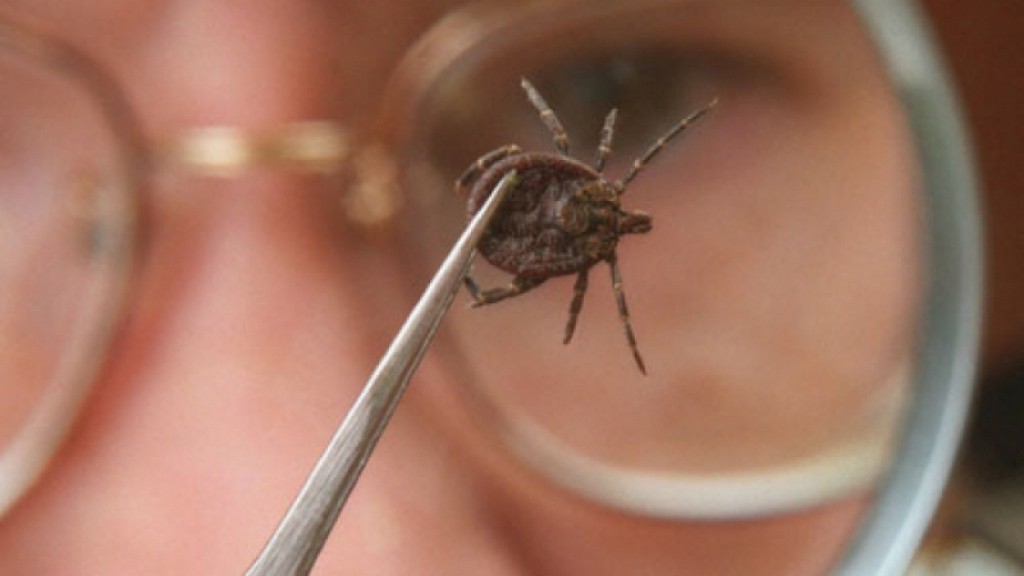
Identification of the tick of the genus and species can help the doctor determine which further diagnostic tests can be scheduled. For example, blood tests for diseases such as Lyme disease, spotted fever in the Rockies, erlichiosis and tularemia will usually not show anything for several weeks after the bite, although the symptoms may already be present. Knowing the type of tick that caused the bite can help narrow down possible diagnoses and even allow the doctor to continue with early therapy before a positive diagnosis is made.
How to pull a mite
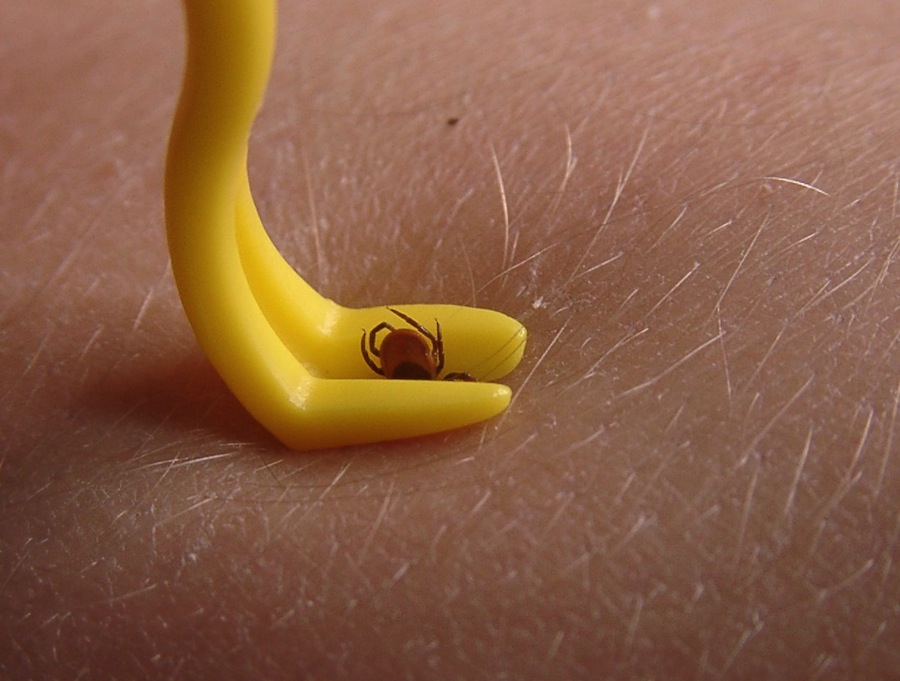
Rinse the bite thoroughly with soap and water or a mild disinfectant. Next, you should observe the area for several days before the development of the reaction in the form of possible symptoms - a rash or symptoms of infection. If within a month there were no changes in the state of health, there was probably no infection.
As prevention of the development of secondary infection in the wound from a bite, you can apply ointment or cream, which includes an antibiotic. The use of an antibiotic on the affected area can help prevent a local infection, but, as a rule, does not affect the likelihood of developing diseases transmitted by ticks.
What should I do if bitten by a tick
If the effects are manifested in the form of severe itching at the site of the bite, preparations containing dimedrol (Benadryl) or other antiallergic agents can be used as external agents. There will also be effective medications prescribed orally, but most of them are prescription-dispensed.
With regard to the treatment of infectious diseases that can go to humans, it depends on other factors, such as the type of mite, the duration of attachment to the host, the presence of other diseases, geographic attachment to the terrain and, of course, the symptoms of the patient. Therefore, what to do if the tick is bitten, everyone decides for himself, but it's best to show the doctor, because the consequences of the lack of treatment can be very sad.
Specific treatment is based on the identification of the pathogen. For example, oral antibiotics may be prescribed for some patients with tick bites if they live in an area where Lyme disease is endemic (occurs very often) and it is necessary to kill the pathogens of this particular disease.
In the presence of more severe symptoms, in combination with antibiotics, it may be necessary to introduce other drugs to exclude the most vivid symptoms. In medicine, this approach to treatment is called symptomatic therapy. In this case the patient can be hospitalized.
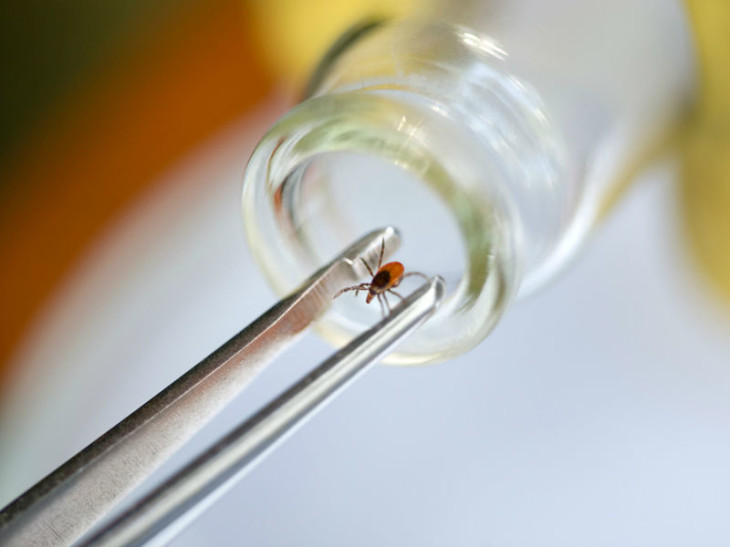
And what is the prognosis?
The overwhelming majority of people who are bitten by ticks, if there is correct observation and timely treatment in a medical institution, fall under a favorable prognosis, since the probability of infection is not so high.
For patients with a suppressed immune system, such as those suffering from HIV, cancer or undergoing chemotherapy, the prognosis is still favorable, but their treating physicians should be informed of all the conditions of the disease in order to assess the consequences. In addition, the faster the tick is removed after a bite, the less likely that the infectious agent has been transmitted.
The general situation for an individual patient changes if the tick transmitted the causative agent of the infection. The prognosis can vary from favorable to cautious, which is determined by the type of disease, its stage and the general condition of the patient. Patients with a weakened immune system tend to have a worse prognosis than healthy people.
With the onset of warm weather, namely spring, summer, autumn, people try to travel to nature. Mushroom pickers spend all day in the woods, fishermen are sitting by the lake, and gardeners are hanging in their kitchen gardens. And many simply go to the forest to get some fresh air. That's it such lovers are most exposed to the dangers that lie in wait in the forest. One of the dangers is that you can be attacked by ticks. You will not feel anything, no bite symptoms. The tick emits a special anesthetic and you do not feel anything.
Photo of the tick
It is important to know what a tick looks like, so as not to confuse it with some kind of bug and because of this "to impose full trousers". If the tick sucks in the skin, it will look like the photo below. Also, the tick is shown in the photo at the beginning of the article.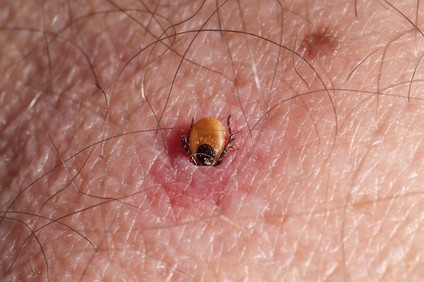
There are areas where there are frequent cases of infection with tick-borne encephalitis. People in such zones are constantly warned about this so that they do not visit the forest. And for those who wish, it is possible to vaccinate against tick-borne encephalitis.
In the woods
If you found a tick in your forest, you can try to remove it immediately. Just do not do it with your bare fingers, it's better to wear gloves or wrap your fingers around with a cloth. It is necessary to squeeze it slightly between the thumb and forefinger. Then pull very gently, swinging it from side to side. After removing the tick, you need to make sure that it is whole. Very often, if it is not properly pulled out and sharply pulled, the head may remain. In this case, the head should not be worth picking, but removing it at home, after appropriate processing. It is desirable to burn a whole mite, because it is very small and tenacious, only so it can be killed. But if there is a glass bank, it is better to place it there, then send it to the survey. The site of the tick bite should be treated with iodine or alcohol solution. If these drugs do not, then the wound must be treated after returning from the forest. It is also desirable to wash your hands, to the person who removed the tick.At home
After visiting the forest, it is necessary to carefully examine all areas of the body for the presence of a sucking mite. It is good to see all the folds, inguinal, axillary and area between the buttocks. Hard-to-reach places can be viewed with a mirror. Inspection should be carried out by all who went to the forest, including animals.If after inspection the tick was found, you can try to remove it yourself. For this, in order not to touch the mite with your hands, it is better to use tweezers. On the mite, you can drop a little vegetable oil, after that, he does not detach himself, but slightly relaxes the grip ( wait 5-10 minutes). Tweezers clamp the mite as deeply as possible. Then slowly, either by swinging, or by pulling the tick with rotational movements. In no case can it be sharply pulled. When the likelihood that the mite can be infected, after removal it is placed in a clean jar with a closing lid. Then they are taken to the laboratory for examination. The site of the tick bite is treated with iodine.
To delete, you can use a thread. It is wrapped around the head of the tick and gently stretched, swinging it. This method is much easier for many.
In the hospital
Many people are afraid of insects and are afraid to pull out the mite on their own. In this case, you can contact the surgeon in the emergency room. The medical method is no different from the usual method of removing the tick. The doctor will use the clamp and gently pull the mite. But doctors have much more experience. And the probability that the head will break is very small. In addition, in a medical institution, the sterile conditions and the wound will be treated correctly. And more, which is very important, the doctor will tell you exactly how dangerous the mites are in the forest where you rested. Accordingly, decide the question of what measures to take.Examination of the tick is carried out for the presence of tick-borne encephalitis and borreliosis viruses. These infections are most often transmitted by mites and occur most severely. But this analysis is carried out at the request of the patient and for his means.
Preventive treatment
If the mite was brought from a zone where there were cases of tick-borne encephalitis, then the doctor will not wait for the result of the analysis, but immediately prescribe a preventive treatment. Most often, the drug "Yodantipirin" is used for this. It is an antiviral drug. He is appointed for 5 days. The first 2 days you need to drink 3 tablets 3 times a day, then the number of tablets decreases to one.There is also a special immunoglobulin for the prevention of tick-borne encephalitis. It is necessarily introduced to all who have treated with a tick bite. In the event that the tick was taken out of the endemic zone by tick-borne encephalitis.
For the prevention of borreliosis, there are no specific drugs. In this case, you can drink a course of antibiotics. But it is better to consult a doctor beforehand.
If there are no dangerous ticks in the area where you rested, then you do not have to worry. But to prevent other, less dangerous infections, you can drink a course of any antiviral drugs. Especially if the tick bitten the child. Adults can drink a course of remantadine, and children better drink anaferon. The course of such prevention is 10 days.
Very important. After a tick bite, you need to monitor the temperature for a month. If during this period there was a marked rise in temperature, it is worthwhile immediately to see a doctor. And when examining a doctor, be sure to draw his attention to the fact that there was a case of sucking the tick.

